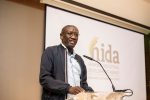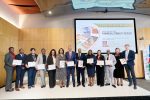In Namibia’s north, within the bountiful and beautiful Otjozondjupa Region, a modern mining company is taking a different approach to managing the unearthing of precious metals.
B2Gold, a low-cost international gold producer with headquarters in Vancouver and operations around the world, has cemented sustainability at the forefront of all thinking in Namibia. Its Otjikoto Gold Mine is home to world-class production standards and high-quality output, but Country Manager John Roos tells Enterprise Africa that gold mining here is about so much more than just atomic number 79.
300km north of Windhoek, Otjikoto is the largest gold mine in the country, producing up to 200,000 ounces of gold annually. Thankfully, Namibia is a shining star in African mining, boasting clear and transparent regulation and developed infrastructure and society.
“The Otjikoto Mine employs around 800 permanent employees and around 300 contractors,” says Roos. “Apart from employing a workforce comprising of 98% Namibians, we make a significant contribution to the Namibian economy in terms of taxes, not to mention our Corporate Social Investment (CSI) programmes which ranks as one of the largest investment portfolios in Namibia.
“Local procurement is high on our agenda and, of everything we do – in the billions of Nambian dollars -, 61% of goods and services are procured locally.”
In 2024, B2Gold expects the Otjikoto Mine to process a total of 3.4 million tonnes of ore at an average grade of 1.77 g/t with a process gold recovery of 98%, delivering gold in a guidance range of between 185,000 and 205,000 ounces.
Open pit mining has been underway on site for more than a decade with mining activities commencing in 2013 as part of the initial development of the mine.
“Otjikoto’s first gold pour was in December 2014; commercial production was achieved a mere three months later on 28 February 2015,” remembers Roos. “We have been producing a steady 150,000 – 200,000 ounces per annum since then.
The year 2022 was a transformative year for us when started production from our Wolfshag Underground Mine. Looking ahead, the Otjikoto Mine will be transitioning to 100% underground mining as of 2026 as the open pit deposit is depleted towards the end of 2025. B2Gold is a mining expert and understands how to transition seamlessly from open pit to underground, keeping loads flowing consistently to the mill.”
LONG-TERM THINKING
B2Gold’s visionary management team is keen to lead in sustainability and so has invested heavily in projects that are not directly linked to the bottom line. In Namibia, the company wants to leave a legacy in an area that is remote and often lacking in opportunity. Away from mining, the local economy is reliant on agriculture, and this is where the company has applied its expertise.
“In Namibia we own a land package of around 18,000 hectares with the Otjikoto Mine’s footprint spanning over some 3,000 hectares of this area,” Roos details. “Adjacent to the Mining Operations we own a 3,800 hectare farm which has been developed through stages into becoming a mid to large scale agricultural farm. The remaining 11,000 hectares comprise of a game reserve area where a wide range of animals roam freely.”
“We acquired the entire land package between 2011 and 2013 when we commenced with the construction of the Otjikoto Mine. When we acquired the land, the farms were traditional cattle operations with bush encroachment being prevalent – not a lot of grazing and not a lot of animals. Over the past decade we have allowed the nature reserve to rehabilitate itself, and we have encouraged it back to health.
B2Gold constructed a large facility on the Otjikoto Nature Reserve which serves as a centre where school children and teachers alike can learn about nature. This centre is also open for researchers from Namibian Universities and abroad to perform various forms of research programs. We are very proud of the fact that we’ve hosted in excess of 5,000 school children at this facility over the past couple of years.
“Going forward, this facility will continue to serve as a research hub where international organisations can partner up with us to further their research activities. We are very excited about the opportunities that this world-class nature reserve holds for the future.”
SUSTAINABLE FOOD PRODUCTION
In 2019, the Company commenced with the process of developing one of its farms, farm Erhardshof, from a traditional cattle farm to an agronomic hub. Following a detailed feasibility study, a proof-of-concept project was launched for the development of 30 hectares of pivot irrigation systems with the objective of producing maize in the summer and wheat in the winter. “Maize is a staple food for the Namibian people – our ultimate aim was to make a meaningful contribution to staple food security in Namibia. Further to this, our objective was to prove that a large-scale agricultural farm could be established that can sustain its own operations financially and contribute to our CSI programmes post mine closure. The proof of concept was a resounding success, and today the company has 90 hectares of irrigated land developed.
“In the 2023/2024 maize season, the B2Gold agronomic project was the largest maize producer in the country for Namib Mills, Namibia’s leading grain milling company. Transitioning from gold mining to agriculture has indeed been a very interesting story,” Roos smiles. Development is currently underway to expand the project by a further 90 hectares, scaling the agronomic project to a large-scale project which will play a meaningful role in the local production of maize in Namibia.
“B2Gold’s post closure vision is a top priority for the local management team and is driven by an overarching strategy at international level,” says Roos. “Our CSI activities follow the company’s wider commitments that fall into four separate categories – health, education, environment and livelihoods
“Through development of the agriculture project and a number of other initiatives underway, we are crafting a structure that will fund CSI projects long after the mine has shut down. We are excited about this next chapter of crafting a post-closure land use model tailored for long-term sustainability,” he adds.
ENERGY EFFICIENT
From a carbon footprint perspective, operating a gold mine is a challenging task when the pressure is continuously on reducing the operation’s carbon footprint. Intense in electricity usage and a generator of significant CO2 emissions, the energy required is costly from both a financial and environmental point of view.
In 2023, B2Gold Corporate set a target to reduce its Scope 1 and 2 greenhouse gas (GHG) emissions by 30% in 2030 against a 2021 baseline. As a company, B2Gold recognises that climate change is a critical global challenge and understands that it must act accordingly. B2Gold has been an innovative leader within the mining industry with respect to the management of sustainability issues and this commitment to GHG emissions reduction forms a key part of its Climate Strategy, incorporating climate management as a part of its business strategy and planning process.
“In Namibia we are leading the charge when it comes to our transition to green energy on the mine,” Roos states.
“Our journey began in 2017 when our corporate office approved the funding for the construction of a 7mWdc solar plant at the Otjikoto Mine. The plant was successfully commissioned in 2018 and now contributes to 13% of the total energy requirement on site. On the back of the success of this plant, B2Gold, shortly after commissioning the Otjikoto Solar Plant, approved the construction of a larger solar plant at its Fekola Mine in Mali. We are investigating various forms of renewable energy at our sites now, including wind power at our Goose Project in Nunavut. We are truly walking the talk when it comes to the green energy transition, Roos explains.”
Integrating solar into the Otjikoto Mine’s energy mix was not the end of the journey; in 2022, the Otjikoto Mine was connected to the NamPower grid following an investment of N$200M into new substations and a 20km overhead line. This connection to the grid weaned the mine from dirty and costly HFO completely. The Otjikoto Mine now produces 13% of its energy from its owned solar plant and the remainder is procured from NamPower.
Currently, a 10MW solar farm is in development 20km from the Otjikoto Mine; in terms of this arrangement, B2Gold will not own the asset but will procure green energy through a power purchase agreement (PPA) from an Independent Power Producer (IPP).
A LEADER IN ESG
Proud of the progress that has been made on site, B2Gold’s management have managed to achieve what few other gold mining companies across Africa have – delivering strong financial results, building robust regional relationships, and being a responsible mining company that will leave a lasting legacy in Namibia.
“From an ESG perspective, the Otjikoto Mine is a showcase of how a mining operation can produce gold responsibly whilst being a leader in mine rehabilitation practices, a leading force in the green transition and a leader in solving for sustainable post closure land use opportunities, using the non-mining assets it owns and making them financially productive. These industry leading initiatives will continue as we have exceptional teams on the ground,” says Roos, adding that the company absolutely wants to be a leader in all things ESG in Namibia.
Enterprise Africa










